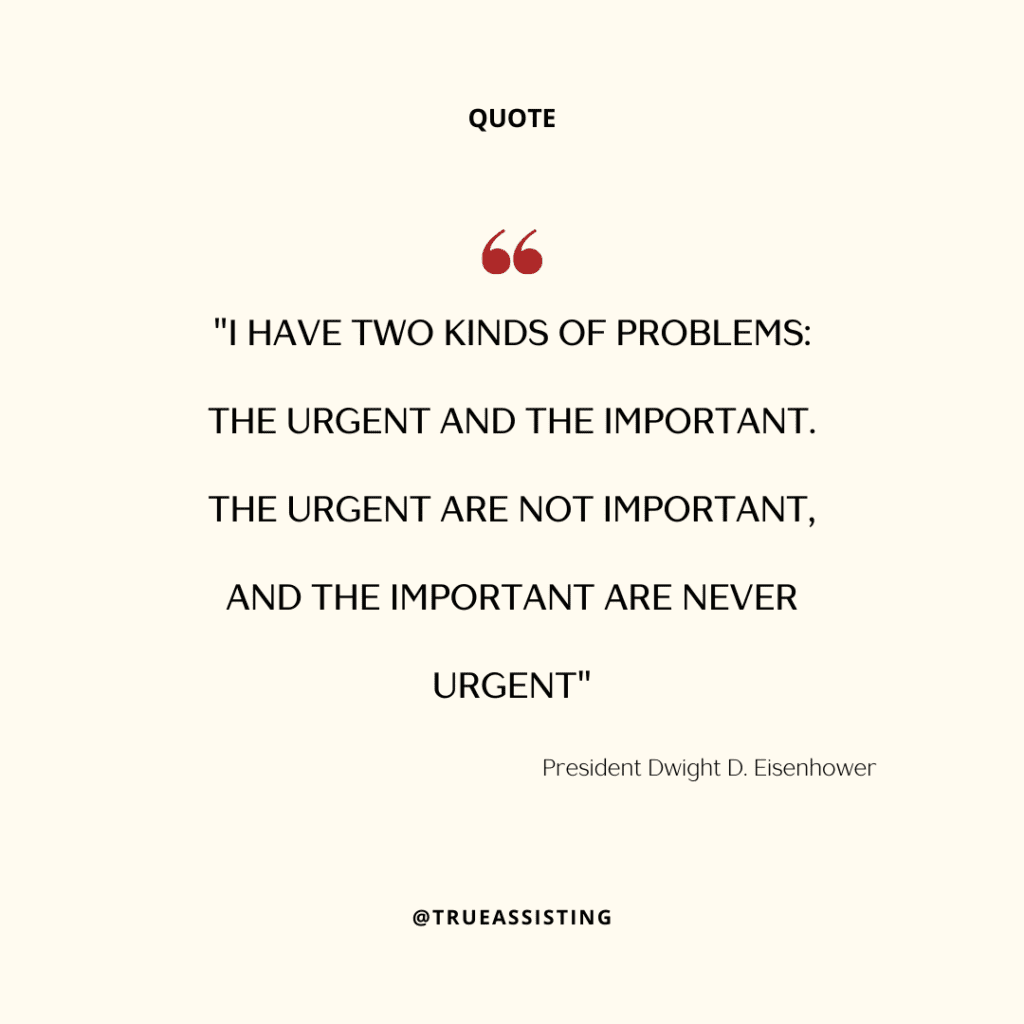Last year was a busy year for us here at True Assisting! I’m still playing catch-up and want to start the new year by setting priorities. If you’re feeling the same way, these nine methods will help you.
Disclosure: This post may contain affiliate links, which means we may receive a commission if you click a link and purchase something we have recommended. This commission comes at no additional cost to you but will help us keep this site up and running and ad-free! Thank you for all the support. You can read our full privacy policy here.
The Eisenhower Matrix
Named after former president Dwight Eisenhower, the matrix is a simple grid with four quadrants that helps people prioritize tasks based on their level of urgency and importance.
Using this matrix, you’ll be able to sort urgent tasks from important ones.
Urgent tasks are things you need to respond to immediately, such as phone calls, news, text messages, etc.
Important tasks are ones that contribute to your long-term goals and mission.
Some tasks will be both urgent and important.
Some will not be either – and those you should drop as soon as possible.
Below, the matrix is set up into four quadrants:
- Urgent and important: do these first
- Important, but not urgent: schedule these
- Urgent, but not important: delegate these
- Neither: drop these
When delegating, you will want to find the right person and explain the task thoroughly. If you’re unsure how much time to plan for this, use the 30x rule.
It takes 30x as long to teach someone as it takes you to do the task.
This may seem like a lot, but you wind up saving 10X the training time over the course of a year.

Master List
If you’ve got a lot of tasks swimming in your head, a master list might be a good option. Think of it as a brain dump.
As you look at this list, you’ll see that different tasks take different amounts of time. However, some need to be done today, and some contribute to your long-term goals and help with a sense of empowerment and completion.
Use this master list to create daily, weekly, and monthly lists. Doing this ensures your tasks are aligned with your bigger goals and helps combat completion bias.
As a result, you’ll spend your time working on meaningful things, not just urgent ones.
ABCDE Method
The biggest challenge with prioritizing is differentiating between tasks that feel like they’re of the same level of importance for many people. If you juggle many tasks and roles, the Pareto Principle and Eisenhower Matrix may not be the right solution.
That’s where the ABCDE Method can help. It’s fairly easy to implement and can offer you a clear path forward.
- Go through your task list and assign everything a letter from A to E, with A being the highest priority.
- For each letter, assign a number that indicates the order you’ll do it. So your list will wind up having A1 – A5 (or 10, or however many A tasks). Same for B through E.
Read: Unlock the Magic of ClickUp
Try ClickUp free today!
Ranking
Similar to the ABCDE method, but focuses on only six tasks. This is helpful if your to-do list is so extensive it feels impossible.
- At the end of each day, write down the six most important things you need to do the following day. Do not write down more than six.
- Prioritize them in order of their true importance.
- When you begin work the next day, start at number one and work on it until it is finished. Then move on to the next one.
- At the end of the day, move any items that aren’t complete to your list for the next day.
Warren Buffet’s Two-List Strategy
You may be a very effective and productive person, but if you’re working towards the wrong goals, that doesn’t help either. Try this to ensure you’re spending your time on the right things.
- Write down your top 25 goals
- Circle your top 5
- Any goal not circled gets moved to the “avoid at all costs” list
- This prevents you from spending your “free time” working on things that aren’t moving you toward your long-term goals and success.
Eat the Frog
How you start your day starts the tone for the rest of it. Getting a big, complicated task (Eat that frog) out of the way first can set you up for success the rest of the day.
Unfortunately, these “frogs” are often the ones where we’re most likely to procrastinate.
When setting up your list for the day, try to put at least one frog at the top of the list. It gets it done and over with early and helps motivate you to do even more.
Use Time Multipliers
No, this isn’t about creating actual time, but it is about giving you more time in the future by working on the right tasks today.
Time multipliers are tools and strategies that give you more time in the future.
This includes things like work environment and habits.
For example, setting up a distraction-free work environment and developing the right habits will help you reach your goals and give you more time in the future.
Do Your Most Important Work During Your Most Productive Hours
It sounds like common sense, but often it’s not how we actually do things.
For example, we all have natural highs and lows of energy, meaning there are certain times of day when you’re naturally more productive.
If you know when your body and mind are already engaged and ready, you can schedule your highest-priority tasks for those hours.
Be Aware of the “Sunk Cost” Fallacy
Remember to be flexible. Things change, and you can’t predict the future.
You may prioritize a task only to have the project needs or deadlines change. While that may be disappointing, don’t let it affect your judgment.
Our minds are wired to want to continue doing something simply because we’ve already put time into it. This is the sunk cost fallacy.
The truth is that no matter what you’ve spent your time on, you can’t get it back. And spending even more time on something that’s no longer a priority means more lost time.
The better solution is to change your priorities and start working on something else that’s aligned with your long-term goals.
Be Realistic
Having priorities are great, but there’s still limited time and energy every day. So be realistic about how much you can get done with the time, energy, and resources you have.
Interruptions happen. Things take longer than planned. Chats with friends and coworkers distract us at times. And all of that is okay! But, by being realistic about how much you can get done, you’ll end each day with a feeling of success.
Which of these methods will you use to help you set priorities in the new year?











